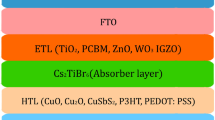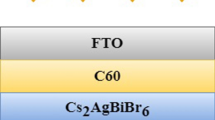Abstract
Conventional lead halide Perovskite Solar Cells (PSC) have toxicity and stability issues. Therefore it is crucial to look for lead-free inorganic perovskite material, such as La2NiMnO6, RbGeI3, CsGeI3, Cs2AgBiBr6 and others. There has been much work in the area of PSC using Cs2AgBiBr6 as an absorber, However, due to some critical issues of Cs2AgBiBr6, such as the film's broad bandgap which limits its capacity to absorb light, leading to corresponding PSC being typically restricted to around 4% efficiency. In this work, a lead-free PSC with Cs2AgBiBr6 as the absorber has been engineered to resolve the issues by considering the experimental works in the literature to increase efficiency to 6.3% from a maximum 4.48% as reported in the literature. The output response of both design approaches, as well as the potentiality of future designs, are investigated in terms of output parameters, i.e., Open-Circuit Voltage (VOC), Short-circuit Current density (JSC), Fill Factor (FF), and Power Conversion Efficiency (PCE). Besides, this work also focuses on eliminating Sulphur from ETLs by working on several sulphides and oxide-based Electron Transport Layers (ETLs). Several solar cell device structures have been analyzed for their numerical simulation with sulphide ETLs such as ZnS, WS2, CdS, CdZnS and oxide ETLs such as TiO2, ZnO, WO3, IGZO. To progress towards eco-friendly PSCs, alternatives to sulphide, several transparent oxide alternatives (TiO2, ZnO, WO3, IGZO) have been considered as ETLs. These ETLs have been further doped with Mg to enhance the performance parameters. Mg-doped based ETLs additionally behaving as Hole-blocking layers (HBLs) in corresponding PSCs leads to comparatively significantly better performance in a number of aspects, including VOC (1.21 V), PCE (5.74%), JSC, and FF. The solar cell design has been optimized for high performance through various techniques such as varying ETL and absorber thickness, interface defects variation, series/shunt resistance, band to band recombination, and bandgap grading through doping. Also an effective electric field (Eeff) that depicts the conduction's impact has been calculated. Best performing device among different designs among PSCs with sulphide and oxide-based ETLs has been ZnS/Cs2AgBiBr6/Cu2O (PCE-6.3%) and Mg-doped (20%) ZnO/Cs2AgBiBr6/Cu2O (PCE-5.74%). These results may help researchers in their efforts to find the best-suited materials for the design of high-performance PSCs in the future.

















Similar content being viewed by others
Data availability
Not applicable.
References
Abdulrahman, A.F., Ahmed, S.M., Ahmed, N.M., Almessiere, M.A.: Enhancement of ZnO nanorods properties using modified chemical bath deposition method: effect of precursor concentration. Crystals 10, 386 (2020). https://doi.org/10.3390/cryst10050386
Ahmed, S., Jannat, F., Khan, M.A.K., Alim, M.A.: Numerical development of eco-friendly Cs2TiBr6 based perovskite solar cell with all-inorganic charge transport materials via SCAPS-1D. Optik (Stuttg) 225, (2021). https://doi.org/10.1016/j.ijleo.2020.165765
Alam, I., Mollick, R., Ashraf, M.A.: Numerical simulation of Cs2AgBiBr6-based perovskite solar cell with ZnO nanorod and P3HT as the charge transport layers. Phys. B Condens. Matter. (2021). https://doi.org/10.1016/j.physb.2021.413187
Arshad, Z., Khoja, A.H., Shakir, S., Afzal, A., Mujtaba, M.A., Soudagar, M.E.M., Fayaz, H., Saleel, C.A., Farukh, S., Saeed, M.: Magnesium doped TiO2 as an efficient electron transport layer in perovskite solar cells. Case Stud. Therm. Eng. 26, 101101 (2021). https://doi.org/10.1016/j.csite.2021.101101
Azri, F., Meftah, A., Sengouga, N., Meftah, A.: Electron and hole transport layers optimization by numerical simulation of a perovskite solar cell. Sol. Energy 181, 372–378 (2019). https://doi.org/10.1016/j.solener.2019.02.017
Bansal, S., Aryal, P.: Evaluation of new materials for electron and hole transport layers in perovskite-based solar cells through SCAPS-1D simulations. 2017 IEEE 44th Photovolt. Spec. Conf. PVSC 2017, 3220–3223 (2017). https://doi.org/10.1109/PVSC.2017.8366107
Burgelman, M., Nollet, P., Degrave, S.: Modelling polycrystalline semiconductor solar cells. Thin Solid Films 361, 527–532 (2000). https://doi.org/10.1016/S0040-6090(99)00825-1
Cao, Z., Li, C., Deng, X., Wang, S., Yuan, Y., Chen, Y., Wang, Z., Liu, Y., Ding, L., Hao, F.: Metal oxide alternatives for efficient electron transport in perovskite solar cells: Beyond TiO2 and SnO2. J. Mater. Chem. A 8, 19768–19787 (2020). https://doi.org/10.1039/d0ta07282f
Chen, J., Luo, Z., Fu, Y., Wang, X., Czech, K.J., Shen, S., Guo, L., Wright, J.C., Pan, A., Jin, S.: Tin(IV)-tolerant vapor-phase growth and photophysical properties of aligned cesium tin halide perovskite (CsSnX3; X = Br, I) nanowires. ACS Energy Lett. 4, 1045–1052 (2019a). https://doi.org/10.1021/acsenergylett.9b00543
Chen, R., Cao, J., Duan, Y., Hui, Y., Chuong, T.T., Ou, D., Han, F., Cheng, F., Huang, X., Wu, B., Zheng, N.: High-efficiency, hysteresis-less, UV-stable perovskite solar cells with cascade ZnO–ZnS electron transport layer. J. Am. Chem. Soc. 141, 541–547 (2019b). https://doi.org/10.1021/jacs.8b11001
Das, S., Chakraborty, K., Choudhury, M.G., Paul, S.: Studies on thickness and internal quantum efficiency of Cs2AgBiBr6 based double perovskite material for photovoltaic application. J. Nano Electron. Phys. 13, 3018 (2021). https://doi.org/10.21272/jnep.13(3).03018
Dette, C., Pérez-Osorio, M.A., Kley, C.S., Punke, P., Patrick, C.E., Jacobson, P., Giustino, F., Jung, S.J., Kern, K.: TiO2 anatase with a bandgap in the visible region. Nano Lett. 14, 6533–6538 (2014). https://doi.org/10.1021/nl503131s
Etacheri, V., Roshan, R., Kumar, V.: Mg-doped ZnO nanoparticles for efficient sunlight-driven photocatalysis. ACS Appl. Mater. Interfaces 4(5), 2717–2725 (2012)
Gao, W., Ran, C., Xi, J., Jiao, B., Zhang, W., Wu, M., Hou, X., Wu, Z.: High-quality Cs2AgBiBr6 double perovskite film for lead-free inverted planar heterojunction solar cells with 2.2 % efficiency. ChemPhysChem 19, 1696–1700 (2018). https://doi.org/10.1002/cphc.201800346
Greul, E., Petrus, M.L., Binek, A., Docampo, P., Bein, T.: Highly stable, phase pure Cs2AgBiBr6 double perovskite thin films for optoelectronic applications. J. Mater. Chem. A 5, 19972–19981 (2017). https://doi.org/10.1039/c7ta06816f
Jeon, N.J., Noh, J.H., Yang, W.S., Kim, Y.C., Ryu, S., Seo, J., Seok, S.I.: Compositional engineering of perovskite materials for high-performance solar cells. Nature 517, 476–480 (2015). https://doi.org/10.1038/nature14133
Ke, W., Stoumpos, C.C., Zhu, M., Mao, L., Spanopoulos, I., Liu, J., Kontsevoi, O.Y., Chen, M., Sarma, D., Zhang, Y., Wasielewski, M.R., Kanatzidis, M.G.: Enhanced photovoltaic performance and stability with a new type of hollow 3D perovskite {en}FASnI3. Sci. Adv. 3, 1–10 (2017). https://doi.org/10.1126/sciadv.1701293
Kharatzadeh, A., Jamali-Sheini, F., Yousefi, R.: Excellent photocatalytic performance of Zn(1 - x)MgxO/rGO nanocomposites under natural sunlight irradiation and their photovoltaic and UV detector applications. Mater. Des. 107, 47–55 (2016). https://doi.org/10.1016/j.matdes.2016.06.007
Kojima, A., Teshima, K., Shirai, Y., Miyasaka, T.: Organometal halide perovskites as visible-light sensitizers for photovoltaic cells. J. Am. Chem. Soc. 131, 6050–6051 (2009). https://doi.org/10.1021/ja809598r
Kwak, C.H., Woo, H.S., Abdel-Hady. F., et al.: Vapor-phase growth of urchin-like Mg-doped ZnO nanowire networks and their application to highly sensitive and selective detection of ethanol. Sensors Actuators, B Chem 223, 527–534 (2016). https://doi.org/10.1016/j.snb.2015.09.120
Li, Z., Wang, R., Xue, J., Xing, X., Yu, C., Huang, T., Chu, J., Wang, K.L., Dong, C., Wei, Z., Zhao, Y., Wang, Z.K., Yang, Y.: Core-shell ZnO@SnO2 nanoparticles for efficient inorganic perovskite solar cells. J. Am. Chem. Soc. 141, 17610–17616 (2019). https://doi.org/10.1021/jacs.9b06796
Liu, Y., Li, X., Wang, J., Xu, L., Hu, B.: An extremely high power factor in Seebeck effects based on a new n-type copper-based organic/inorganic hybrid C6H4NH2CuBr 2I film with metal-like conductivity. J. Mater. Chem. A 5, 13834–13841 (2017). https://doi.org/10.1039/c7ta03015k
Mohandes, A., Moradi, M., Nadgaran, H.: Numerical simulation of inorganic Cs2AgBiBr6 as a lead-free perovskite using device simulation SCAPS-1D. Opt. Quantum Electron. 53, 1–22 (2021). https://doi.org/10.1007/s11082-021-02959-z
Ngoupo, A.T., Ouédraogo, S., Zougmoré, F., Ndjaka, J.M.B.: Numerical analysis of ultrathin Sb2Se3-based solar cells by SCAPS-1D numerical simulator device. Chin. J. Phys. 70, 1–13 (2021). https://doi.org/10.1016/j.cjph.2020.12.010
Niemegeers, A., Burgelman, M.: Numerical modelling of ac-characteristics of CdTe and CIS solar cells. In: Conference Record of the Twenty Fifth IEEE Photovoltaic Specialists Conference-1996, pp. 901–904. (1996). https://doi.org/10.1109/pvsc.1996.564274
Niemegeers, A., Burgelman, M., Decock, K., Verschraegen, J., Degrave, S.: SCAPS manual. University of Gent, 13 (2014)
NREL, Best Research-Cell Efficiency Chart, in, 2022, Available: https://www.nrel.gov/pv/cell-efficiency.html
Paquin, F., Rivnay, J., Salleo, A., Stingelin, N., Silva, C.: Multi-phase semicrystalline microstructures drive exciton dissociation in neat plastic semiconductors. J. Mater. Chem. C 3, 10715–10722 (2015). https://doi.org/10.1039/b000000x
Pindolia, G., Shinde, S.M., Jha, P.K.: Optimization of an inorganic lead free RbGeI 3 based perovskite solar cell by SCAPS-1D simulation. Sol. Energy 236, 802–821 (2022)
Rafieirad, R., Ganji, B.A.: Efficiency improvement of perovskite solar cells by utilizing cuins thin layer: modeling and numerical study. IEEE Trans. Electron Devices. 68, 4997–5002 (2021). https://doi.org/10.1109/TED.2021.3102536
Rai, N., Rai, S., Singh, P.K., Lohia, P., Dwivedi, D.K.: Analysis of various ETL materials for an efficient perovskite solar cell by numerical simulation. J. Mater. Sci. Mater. Electron. 31, 16269–16280 (2020). https://doi.org/10.1007/s10854-020-04175-z
Salem, M.S., Shaker, A., Othman, M.S., Al-Bagawia, A.H., Fedawy, M., Aleid, G.M.: Numerical analysis and design of high performance HTL-free antimony sulfide solar cells by SCAPS-1D. Opt. Mater. (amst). (2022). https://doi.org/10.1016/j.optmat.2021.111880
Schade, L., Mahesh, S., Volonakis, G., Zacharias, M., Wenger, B., Schmidt, F., Kesava, S.V., Prabhakaran, D., Abdi-Jalebi, M., Lenz, M., Giustino, F., Longo, G., Radaelli, P.G., Snaith, H.J.: Crystallographic, optical, and electronic properties of the Cs2AgBi1−xInxBr6 double perovskite: understanding the fundamental photovoltaic efficiency challenges. ACS Energy Lett. 6, 1073–1081 (2021). https://doi.org/10.1021/acsenergylett.0c02524
Shi, Z., Guo, J., Chen, Y., Li, Q., Pan, Y., Zhang, H., Xia, Y., Huang, W.: Lead-free organic-inorganic hybrid perovskites for photovoltaic applications: recent advances and perspectives. Adv. Mater. (2017). https://doi.org/10.1002/adma.201605005
Shukla, R., Kumar, R.R., Pandey, S.K.: theoretical study of charge carrier lifetime and recombination on the performance of eco-friendly perovskite solar cell. IEEE Trans. Electron Devices 68, 3446–3452 (2021). https://doi.org/10.1109/TED.2021.3078063
Sirtl, M.T., Hooijer, R., Armer, M., Ebadi, F.G., Mohammadi, M., Maheu, C., Weis, A., van Gorkom, B.T., Häringer, S., Janssen, R.A.J., Mayer, T., Dyakonov, V., Tress, W., Bein, T.: 2D/3D hybrid Cs2AgBiBr6 double perovskite solar cells: improved energy level alignment for higher contact-selectivity and large open circuit voltage. Adv. Energy Mater. (2022). https://doi.org/10.1002/aenm.202103215
Stranks, S.D., Eperon, G.E., Grancini, G., Menelaou, C., Alcocer, M.J.P., Leijtens, T., Herz, L.M., Petrozza, A., Snaith, H.J.: Electron-hole diffusion lengths exceeding 1 micrometer in an organometal trihalide perovskite absorber. Science 342, 341–344 (2013). https://doi.org/10.1126/science.1243982
Wang, Y., Fan, H., Zhao, G., Liu, D., Du, L., Wang, Z.: High quality Cs2AgBiBr6 double perovskite film for lead-free inverted planar heterojunction solar cells with 2.2% efficiency. Chem. Phys. Chem. 19(14), 1696–1700 (2012). https://doi.org/10.1111/febs.12037
Wang, J., Qin, M., Tao, H., Ke, W., Chen, Z., Wan, J., Qin, P., Xiong, L., Lei, H., Yu, H., Fang, G.: Performance enhancement of perovskite solar cells with Mg-doped TiO2 compact film as the hole-blocking layer. Appl. Phys. Lett. DOI 10(1063/1), 121104 (2015)
Wang, D., Wright, M., Elumalai, N.K., Uddin, A.: Stability of perovskite solar cells. Sol. Energy Mater. Sol. Cells 147, 255–275 (2016). https://doi.org/10.1016/j.solmat.2015.12.025
Wang, M., Zeng, P., Bai, S., Gu, J., Li, F., Yang, Z., Liu, M.: High-quality sequential-vapor-deposited Cs2AgBiBr6 thin films for lead-free perovskite solar cells. Sol. RRL 2, 1–6 (2018). https://doi.org/10.1002/solr.201800217
Wang, S., Wang, A., Deng, X., Xie, L., Xiao, A., Li, C., Xiang, Y., Li, T., Ding, L., Hao, F.: Lewis acid/base approach for efficacious defect passivation in perovskite solar cells. J. Mater. Chem. A 8, 12201–12225 (2020). https://doi.org/10.1039/d0ta03957h
Wang, B., Li, N., Yang, L., Agnese, C.D., Jena, A.K., Miyasaka, T., Wang, F.: Organic dye/Cs2 AgBiBr6 double perovskite heterojunction solar cells. J. Am. Chem. Soc. 143(36), 14877–14883 (2021a)
Wang, B., Li, N., Yang, L., Dall’agnese, C., Jena, A.K., Sasaki, S.I., Miyasaka, T., Tamiaki, H., Wang, X.F.: Chlorophyll derivative-sensitized TiO2 electron transport layer for record efficiency of Cs2AgBiBr6 double perovskite solar cells. J. Am. Chem. Soc. 143, 2207–2211 (2021b). https://doi.org/10.1021/jacs.0c12786
Yadav, M.K., Ghosh, M., Biswas, R., Raychaudhuri, A.K., Mookerjee, A., Datta, S.: Band-gap variation in Mg- and Cd-doped ZnO nanostructures and molecular clusters. Phys. Rev. B Condens. Matter Mater. Phys. 76, 1–9 (2007). https://doi.org/10.1103/PhysRevB.76.195450
Yang, W.S., Park, B.W., Jung, E.H., Jeon, N.J., Kim, Y.C., Lee, D.U., Shin, S.S., Seo, J., Kim, E.K., Noh, J.H., Seok, S.I.: Iodide management in formamidinium-lead-halide-based perovskite layers for efficient solar cells. Science 356, 1376–1379 (2017). https://doi.org/10.1126/science.aan2301
Yella, A., Heiniger, L.P., Gao, P., Nazeeruddin, M.K., Grätzel, M.: Nanocrystalline rutile electron extraction layer enables low-temperature solution processed perovskite photovoltaics with 13.7% efficiency. Nano Lett. 14, 2591–2596 (2014). https://doi.org/10.1021/nl500399m
You, J., Meng, L., Song, T.B., Guo, T.F., Chang, W.H., Hong, Z., Chen, H., Zhou, H., Chen, Q., Liu, Y., De Marco, N., Yang, Y.: Improved air stability of perovskite solar cells via solution-processed metal oxide transport layers. Nat. Nanotechnol. 11, 75–81 (2016). https://doi.org/10.1038/nnano.2015.230
Yousefi, R., Kamaluddin, B.: Fabrication and characterization of ZnO and ZnMgO nanostructures grown using a ZnO/ZnMgO compound as the source material. Appl. Surf. Sci. 256, 329–334 (2009). https://doi.org/10.1016/j.apsusc.2009.08.025
Yousefi, R., Zak, A.K., Jamali-Sheini, F.: Growth, X-ray peak broadening studies, and optical properties of Mg-doped ZnO nanoparticles. Mater. Sci. Semicond. Process 16, 771–777 (2013). https://doi.org/10.1016/j.mssp.2012.12.025
Zhang, C., Gao, L., Hayase, S., Ma, T.: Current advancements in material research and techniques focusing on lead-free perovskite solar cells. Chem. Lett. 46, 1276–1284 (2017). https://doi.org/10.1246/cl.170345
Zhang, T., Li, H., Ban, H., Sun, Q., Shen, Y., Wang, M.: Efficient CsSnI3-based inorganic perovskite solar cells based on a mesoscopic metal oxide framework via incorporating a donor element. J. Mater. Chem. A 8, 4118–4124 (2020). https://doi.org/10.1039/c9ta11794f
Zhao, D., Liang, C., Wang, B., Liu, T., Wei, Q., Wang, K., Gu, H., Wang, S., Mei, S., Xing, G.: Overcoming the limitation of Cs2AgBiBr6 double perovskite solar cells through using mesoporous TiO2 electron extraction layer. Energy Environ Mater 1317–1322 (2021). https://doi.org/10.1002/eem2.12249
Zhou, H., Chen, Q., Li, G., Luo, S., Song, T.B., Duan, H. S., Yang, Y.: Interface engineering of highly efficient perovskite solar cells. Science 345(6196), 542–546 (2014)
Acknowledgements
The authors acknowledge the Department of Science and Technology (DST), Govt. of India for the financial assistance provided under DST SERB Project (File No. SRG/2021/002110) to carry out the present work. Dr. Amitesh Kumar would like to thank DST SERB for providing a Start-up Research Grant for this project to conduct research at NIT Patna. Mr. Parshuram Singh would like to thank the Ministry of Education and NIT Patna for the research fellowship. The authors are thankful to NIT Patna for providing research facilities.
Funding
The authors acknowledge the Department of Science and Technology (DST), Govt. of India for the financial assistance provided under DST SERB Project (File No. SRG/2021/002110) to carry out the present work.
Author information
Authors and Affiliations
Contributions
PS: Conceptualization, Methodology, Software, Data curation, Visualization, Investigation Writing—Original draft preparation. AK: Conceptualization, Methodology, Supervision, Reviewing and Editing. Visualization, Investigation.
Corresponding author
Ethics declarations
Conflict of interest
The authors declare that they have no known competing financial interests or personal relationships that could have appeared to influence the work reported in this paper.
Consent to participate
Not applicable.
Consent for publication
The authors have given Consent for Publication as per the journal policy.
Ethical approval
Not applicable. The work presented in this manuscript is modeling only for the proposed solarcell. No experiment was performed on the human body and living organism/animal. So, ethical approval from an ethical committee is not required.
Additional information
Publisher's Note
Springer Nature remains neutral with regard to jurisdictional claims in published maps and institutional affiliations.
Rights and permissions
Springer Nature or its licensor (e.g. a society or other partner) holds exclusive rights to this article under a publishing agreement with the author(s) or other rightsholder(s); author self-archiving of the accepted manuscript version of this article is solely governed by the terms of such publishing agreement and applicable law.
About this article
Cite this article
Singh, P., Kumar, A. Device engineering of double perovskite based solar cells towards high-performance, eco-friendly solar cells. Opt Quant Electron 55, 304 (2023). https://doi.org/10.1007/s11082-023-04580-8
Received:
Accepted:
Published:
DOI: https://doi.org/10.1007/s11082-023-04580-8




